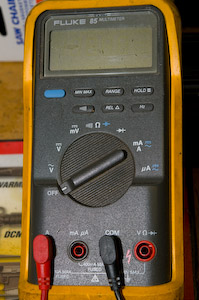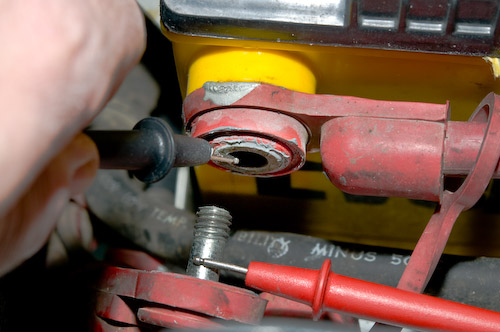 Image via Wikipedia
Image via WikipediaWhat is parasitic draw? All vehicles draw some power from the batteries when the car is shut off. Certain accessories such as clocks, radios remote door openers and alarms always need power. The normal power used is called parasitic draw. It is always a very low draw so it doesn't run the battery down. If you install accessories like shortwave radios or plug things like invertors and portable refrigerators into the accessory socket and operate them too long without the engine running you can drain your batteries to the point where the engine won't start. If there is an electrical short in the vehicle or a malfunctioning accessory it could be drawing much more than its normal load causing a drain on the batteries. If you leave your door open and the inside lights stay on all night you could drain the battery down till the car won't start. My 98 draws 3.5 amps with the front door open. Usually what happens is the truck is dead when you first go to start it.
The first thing to do is a test for a major short. Remove the positive and negative cables from the batteries. Put an Ohm-meter across the positive and negative cable. If your reading is close to 0 Ohms then you have a direct short. I read 150 ohms on my stock 98. You need to trace the short before you can perform the following tests.
 In order to check for parasitic draw, you need to be careful so you don't ruin your meter. At the risk of sounding like an elementary teacher, here's what you need to do.
In order to check for parasitic draw, you need to be careful so you don't ruin your meter. At the risk of sounding like an elementary teacher, here's what you need to do.- If you don't already have one, get a digital meter capable of reading up to 10 amps DC. Sears sells them for less than $50 - I bought one on sale for $14.99 that I leave in my truck.
- Your battery must have a reasonable charge for this test - it won't work if your battery is dead. Quick proof - if your dome light operates normally, you're fine. My truck wouldn't start and the batteries were down to 5.5 volts so I put a charger on the batteries overnight. They are now 12.2 V. When I started the truck the voltage went to 14.3 V so the alternator is working.
- Check to make sure ALL loads are turned off. Unplug anything you may have plugged into the cigarette lighter. Remove your keys from the ignition. Close all doors so the dome lights are off.
- Disconnect the thick positive (Red) cable that goes down to the starter.
- To start make sure your meter is set to the 10 amp DC range. Some meters have a special connector for the red probe when you are reading current. The meter pictured on the left has one jack for high amps and one for low amps. If yours does, make sure the meter end of the probe is in the right connector. You can either do this next step by just holding the meter probes to their respective contact points (you won't get a shock from 12 volts) or you can use probes with alligator clips to snap them in place so your hands are free to do something else.
- Connect the positive probe to the battery - either battery is fine, electrically speaking, since they are connected together by the negative (Black) wires. Polarity on digital meters doesn't matter because they are autosensing.
- Connect the negative probe to the red cable that is still connected to the vehicle. Make sure this cable and your probe do not touch ground.
- If there is a severe current draw (more than 10 amps) it will either pop a fuse in your meter or destroy it outright. That's why you need to test for a short, otherwise, your meter should now be reading the current drain on your battery.
- If your vehicle has an alarm system or remote locks, the current draw may be around 2-3 amps for a few minutes after you last close the door. This is normal. If you're not sure, wait at least 20 minutes after you last open or close a door before you take a reading.
- If everything is normal, you will read less than 35 milliamps, or .035 amps. If the current drain is higher than that, you need to find out what is draining your batteries: You can start by pulling fuses until the load goes away. If that doesn't reduce the draw, you need to look for a wire that is corroded or frayed.
Happy Hunting!

Measuring Current Draw
It took awhile to figure it all out over several YEARS. I kept replacing batteries, with the problem much worse in the winter than summer, when it was rainy than dry.
I had several shorts in my truck.
- the winch
- the light system to all gauges
- a hot wire to an amplifier
When you do a parasitic draw test in a dual battery system and you have an electric winch, you should rewire the truck temporarily as two separate circuits, one to the winch and one to the truck. Each should be checked independently from the other.
If you are drawing too much current in the truck, my first steps would be to check engine compartment components. Disconnect the hot wire to the alternator to rule out diode backdraw in the alternator itself. Then, disconnect the main engine cable connection to the electrical block.
Disconnect all add-on components wired directly to the battery or positive main engine block terminals. Look for elimination of the excessive amperage draw, one item at a time. Disconnect the starter motor, check the draw.
Once the engine compartment is ruled out, I would go to the fuse box under the dashboard and disconnect all add-on components wired to the fuse box or extra hot leads (one always hot, one ignition controlled hot) that AMG supplies for add-ons. Do this one at a time, looking for correction of your excessive current draw.
Finally, I would pull all fuses one at a time.
In my case I had corrosion on the winch hand controller connection that allowed for a constant low current flow. Even the wires to the winch were blackened inside their insulation. The winch itself never activated spontaneously. I moved that connection far away from the winch and away from salt spray from the road.
I had a short in the shifter that ultimately caused a short to ground and blew fuses when I turned on the lights which activates the panel lights. I replaced the shifter (obviously, more to this story).
I had a large aftermarket hot wire to the amplifier (connected to the battery with a fuse) that rubbed the insulator coat off and grounded to the body when it was wet or metal of the body contracted in the cold and completed the circuit.